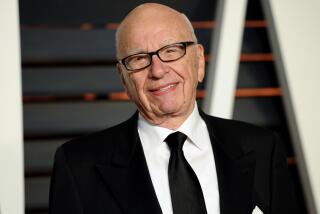USX Forges New Identity in Oil Patch : Manufacturing: Holders are expected to back a split of U.S. Steel from Marathon Oil. Analysts say the move could get the parent firm out of the steel business within a decade.
- Share via
DETROIT — When the leaders of USX Corp. travel from Pittsburgh to Houston for Monday’s annual shareholders meeting, they will find the Oil Patch a good fit.
Shareholders of the company once known as U.S. Steel Corp., but now dominated by its Marathon Oil Co. subsidiary, are expected to bless a stock plan that affirms the gradual fade-out of what--even in today’s shrunken form--remains the nation’s biggest steel producer.
Its passing will be another coda to the turbulent 1980s, when the nation’s manufacturing sector was unmasked as not up to the task of international competition, then reinvented as a smaller, more efficient economic force.
Fused by financier J. P. Morgan in 1901 in a merger with Andrew Carnegie’s steel company, U.S. Steel dominated an industry that led the world until a long nationwide strike in 1959 opened the door to imported steel.
Three decades later, its identity changed and its markets diluted, the steel company is expected to slowly dissolve, its still-vast facilities for making steel likely to be sold off piecemeal to anyone offering a decent price.
The immediate debate focuses neither on steel nor oil but on the value of USX stock--a fact that, to some, befits the firm’s transformation into more a holding company than an industrial behemoth. Its products, laments labor expert Ben Fischer at Carnegie Mellon University in Pittsburgh, have become all but irrelevant to top managers led by Chairman Charles A. Corry, a tax attorney by training and career USX executive.
“It’s more and more a finance company,” Fischer said. “Mostly, the CEOs have been interested in and culturally steeped in steel. Corry is much less so.”
In its early days, U.S. Steel produced two-thirds of the nation’s steel. Price increases or the occasional prospect of a nationwide strike against the industry led by U.S. Steel prompted White House intervention time and again lest steel shortages jeopardize the economy or national security.
But a flood of imported, cheaper and often higher-quality steel, the advent of more efficient mini-mills, the declining role of steel generally and the woes of the U.S. auto companies dealt the domestic steel industry a profound blow in the 1970s and early 1980s, creating overcapacity that persists today despite the wholesale closure of aging steel facilities.
At U.S. Steel, the radical surgery began with the purchase of Marathon Oil for $6 billion after a 1982 bidding war with Mobil Oil Corp. The Marathon buy was intended to offset the nose dive of the steel industry, but oil prices proceeded to drop for four years and the acquisition was roundly attacked by investors and workers.
By the late 1980s, the low prices had driven up oil demand, and Marathon was prospering. It is principally a refiner and marketer of oil products in the Midwest under such service station brands as Marathon, Speedway and Starvin’ Marvin. It also operates the huge Yates oil field in Texas and has sizable crude reserves in Britain’s North Sea.
The way energy analyst Scott Jones of AUS Consultants in Philadelphia sees it, Marathon was nimble enough to weather hard times in the Oil Patch and prop up the steel division while it modernized, sold or padlocked its steel mills and slashed its work force.
“Without Marathon, U.S. Steel stockholders would have been holding shares in a bankrupt company,” said Jones, who counts USX among his clients. “I’m not sure what Marathon shareholders got out of it.”
Meanwhile, the company’s steel division, called USS, was dramatically restructured. In addition to buying Marathon and Texas Oil & Gas Co., the firm sold off $7 billion in assets that its various managements had picked up over the decades.
The company entered into nearly a dozen joint ventures, notably one at its sheet-steel mill in Pittsburg, Calif., with Pohang Iron & Steel Co. of South Korea. Dozens of facilities were closed outright. Contrasted with 1974, steel employment has tumbled by nearly 90%.
Today, USX’s steel operations have 80,000 retirees and just 20,000 active workers. Its raw steelmaking capacity is about half what it was in the late 1970s, and the company claims just 13% of the U.S. steel market.
Both Marathon and USS became solidly profitable in the process. By last year, Marathon accounted for two-thirds of USX’s $1.5 billion in operating profit and a like proportion of its $20.6 billion in sales. Sharing in a general U.S. steel industry recovery driven by its modernization and an improved export climate, USX got an extra edge from the timing of United Steelworker concessions that last year gave it significantly lower labor costs than the industry average.
The company’s restless investors, however, have reaped little from all the restructuring. But they should get a quick answer to the central question posed by USX’s plan to separate its steel business from its oil business: Are the company’s parts worth more than the whole?
In an accommodation with investor Carl C. Icahn, who owns about 13.3% of the company, USX managers are asking shareholders to approve Monday the creation of a separate stock issue tied mainly to the fortunes of the firm’s steel division. The old shares would become energy stock. An owner of 100 current shares would get 100 energy shares (with the stock symbol MRO, for Marathon Oil) and 20 steel shares (symbol X).
“Our objective is to achieve ‘pure play’ investment opportunities for our shareholders,” Corry said.
The idea all along has been that the energy shares would be more valuable when unshackled from the troubled steel industry. Steel’s cyclical woes were underscored last week when USX reported a first-quarter operating loss of $502 million on steel--the recession drove steel output down to 55% of capacity--more than offsetting a tidy profit of $229 million on energy.
Still, nobody knows if the theory will hold. The steel and energy divisions will still overlap in certain ways, and some investors insist that the steel stock will benefit before the energy stock.
So far, limited trading of the shares on a “when-issued” basis has valued the two categories of stock at the equivalent of about $5 for steel and $27 for energy--adding up to the current stock’s price of $32.
But a lot of investors who have watched their USX holdings go nowhere in the past decade while the stock market was tripling in value have high hopes for the new stock arrangement--although not so high as to be sinking more money into the company.
“We’ve got our position and are content to stay with it,” said Martin D. Sass, head of M .D. Sass Investors Service, a New York money-management firm that holds about 640,000 shares. Sass sees prices of both categories of stock rising gradually as a result of the separate issues. If shareholders approve, the trading would start Tuesday morning on the New York Stock Exchange.
USX has long been among the Dow Jones industrials, the index of 30 blue chip stocks anointed by publisher Dow Jones as the chief barometer of the New York Stock Exchange. But last week Dow Jones announced that Walt Disney Co. would supplant USX on the roster of Dow industrials.
Dividing the stock in two will pretty well reflect the nature of USX’s business. There never was any real blending of oil and steel, analysts say; Marathon and USS have operated independently. But coming from two industries with mechanical and engineering cultures, they were able to speak to each other.
“It’s not as if one of them was in fashion or cosmetics,” said Stephen A. Smith, the oil analyst at Bear, Stearns & Co.
A relative handful of Marathon people moved to the 62-story USX building in downtown Pittsburgh, tallest between New York and Chicago, from the oil company’s longtime headquarters in Findlay, Ohio. USX sold the place for $250 million in 1982 and rents about one-fourth of the space, compared to the two-thirds it once occupied.
Last year, meanwhile, Marathon President Victor G. Beghini, who is also vice chairman of USX, moved Marathon’s headquarters from Findlay to Houston. About 2,000 Marathon employees remain in Findlay, while 1,000 work in Houston.
Despite four years of profitability since 1986, USX’s stock has remained a “mediocre” performer, as investor Sass charitably puts it. That led to Icahn’s demand--rebuffed by shareholders a year ago--that USX break itself into two stand-alone companies.
But USX officials, after trying unsuccessfully to sell the company’s steel division to British Steel, came up with the modified steel-stock plan that satisfied the otherwise-occupied Icahn, chairman of troubled Trans World Airlines.
Icahn agreed to vote for the plan and not buy any more USX shares. He is thought likely to hold his stake in USX until the markets place a clear value on the new shares and the steel industry recovers from the current recession--developments that might earn him some money.
As for the shareholder vote, “we have heard zero opposition,” said a USX spokesman.
The new stock structure won’t itself hasten or delay a dissolution of USX’s steel business, company and outside observers say. But veteran steel analyst Charles Bradford of London-based UBS Phillips & Drew said the generous dividend proposed for the new steel stock--at a time when pure-steel producers are slashing or eliminating dividends--makes a breakup all but inevitable.
Said labor expert Fischer, a former United Steelworkers official: “They’ll probably be joint-ventured to death.”
The stock plan increases USX’s $1.40-per-share annual payout to $1.60, with the extra 20 cents for the new “X” stock. The 20-cent per share dividend on the steel stock would be paid from steel’s cash flow.
After 1992, when USS will have completed another $850 million of steel mill upgrades, investment in what remains a glutted steel market will fall dramatically so that the funds from cash flow can be used to support the dividend and thus bolster the steel stock’s price, Bradford predicted.
“It means they’re basically liquidating” the steel facilities, Bradford said. “The idea is to sell.”
A company spokesman said that characterization of steel spending plans is “Mr. Bradford’s opinion,” though Corry has said he would continue to seek buyers.
One good thing about the separate shares, Bradford added, is that maybe oil analysts will stop painting a misleadingly rosy picture of USX’s steel operations and floating “laughable” rumors about investors standing in line to buy the company’s steel mills. They have done so, he said, to boost the lagging price of USX shares.
Rattling off the names of companies big enough to buy USS--mostly foreign steelmakers--Bradford said: “There’s no interest, I assure you. None of their facilities are outstanding. They are night-and-day better compared to where they were, but on any kind of world-class basis, these guys don’t compare.”
That doesn’t make the new ‘X’ stock a bad investment, necessarily. Though Bradford figures it is worth $4, compared to the $5 at which it is preliminarily trading, investor Sass sees things differently.
Because the steel division’s heavy pension and debt obligations will ultimately be shouldered by the parent USX, there is less risk in USS than in other steel producers, he said--and its dividend yield will be the best in the industry.
But at USX, steel is a sideshow.
For Sass and other investors, the centerpiece is Marathon. Some people even expect USX eventually to move its headquarters, like this year’s annual meeting, to Houston.
Life goes on: For U.S. Steel’s first 60 years or so, the chairman’s office was in New York, where Morgan--by any measure a financier rather than a steel man--made his headquarters. And the annual meeting was in Hoboken, N.J.
“To the extent there’s a tradition,” said a U.S. Steel retiree, “it is Hoboken.”
More to Read
Inside the business of entertainment
The Wide Shot brings you news, analysis and insights on everything from streaming wars to production — and what it all means for the future.
You may occasionally receive promotional content from the Los Angeles Times.










